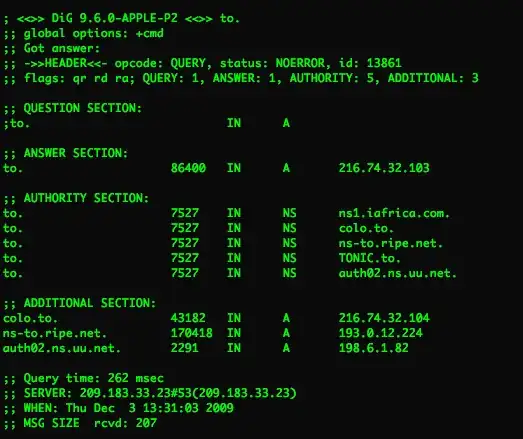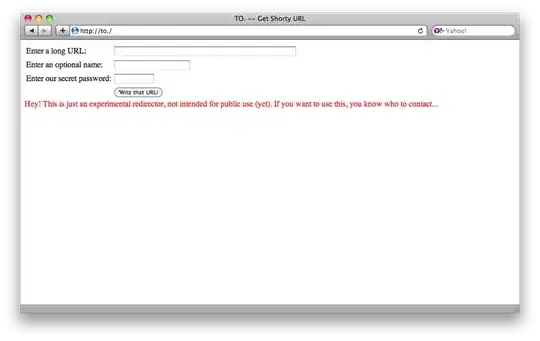Any DNS zone can have any DNS record for that zone itself (in a bind configuration file, this record is labeled with an @). Actually -- let me ask this -- can the root zone have an @ to describe itself? IE can @ have an address record? I don't see why it couldn't. that would be a cool address to have. "http://./"
The "Root" zone is simply a zone named ".". At the moment, that zone has a bunch of name servers. The addresses of these name servers are distributed as a text file. This text file or something similar is manually entered into many typical recursive name servers.
Placing a "." at the end of a name tells your local resolver that the name you have entered a "fully qualified" domain name, meaning it is exactly and only the name you wish to look up. Often, we use unqualified or otherwise ambiguous names such as "www" to mean "www.of.the.place.I.work" where your local DNS resolver has "of.the.place.I.work" as the "dns domain" or "search domain".
These root level domain servers have a list of "top level" domains which map roughly to old abstractions of how researchers in the 80s thought the internet would be used and countries, and a top level domain for "infrastructure". Each of these top level domains has a bunch of name servers that have lists of actual zones in that domain, so a request for maps.google.com first goes to a root level server which passes out a list of name servers that know about .com, and when asked, one of those knows about which name server has records for google.com, and one of those knows the specific record for www.google.com.
So, all you need to do is convince whoever runs the TLD for a country or organization to put in an address record for .zone instead of just google.zone and you're golden.
At present, the following top level domains have address records (not all run web servers, though)
ac has address 193.223.78.210
ai has address 209.59.119.34
bi has address 196.2.8.205
cm has address 195.24.205.60
dk has address 193.163.102.23
gg has address 87.117.196.80
hk has address 203.119.2.28
io has address 193.223.78.212
je has address 87.117.196.80
ph has address 203.119.4.7
pn has address 80.68.93.100
pw has address 203.199.114.33
sh has address 64.251.31.234
tk has address 217.119.57.22
tm has address 193.223.78.213
to has address 216.74.32.103
uz has address 91.212.89.8
ws has address 63.101.245.10
and the following have mx records (so user@TLD. is a potentially deliverable address)
ai mail is handled by 10 mail.offshore.ai.
as mail is handled by 10 dca.relay.gdns.net.
cf mail is handled by 10 mail.intnet.cf.
dj mail is handled by 5 smtp.intnet.dj.
dj mail is handled by 5 relais2.intnet.dj.
dm mail is handled by 10 mail.nic.dm.
gp mail is handled by 20 manta.outremer.com.
gp mail is handled by 5 ns1.nic.gp.
gp mail is handled by 10 ns34259.ovh.net.
gt mail is handled by 10 mail.gt.
hr mail is handled by 10 alpha.carnet.hr.
io mail is handled by 10 mailer2.io.
kh mail is handled by 10 ns1.dns.net.kh.
km mail is handled by 110 bow.snpt.km.
km mail is handled by 100 mail1.comorestelecom.km.
mh mail is handled by 10 imap.pwke.twtelecom.net.
mh mail is handled by 20 mx1.mail.twtelecom.net.
mh mail is handled by 30 mx2.mail.twtelecom.net.
mq mail is handled by 10 mx1-mq.mediaserv.net.
ne mail is handled by 20 bow.rain.fr.
ne mail is handled by 10 bow.intnet.ne.
pa mail is handled by 5 ns.pa.
td mail is handled by 0 mail.intnet.td.
tt mail is handled by 0 66-27-54-138.san.rr.com.
tt mail is handled by 10 66-27-54-142.san.rr.com.
ua mail is handled by 10 mr.kolo.net.
va mail is handled by 20 paul.vatican.va.
va mail is handled by 50 proxy2.urbe.it.
va mail is handled by 90 john.vatican.va.
va mail is handled by 10 lists.vatican.va.
ws mail is handled by 10 mail.worldsite.ws.
(I really wonder about what's going on with "tt" here...)
So, in theory, you could send email to pope@va. and it will be delivered properly...
If you use different root servers, you will wind up with a different view of what exists on the internet. All the local resolutions I did were against my local system which is using "dnscache" which goes directly to the root servers. Many other resolving DNS servers will ask another local DNS server instead of asking the root servers.


